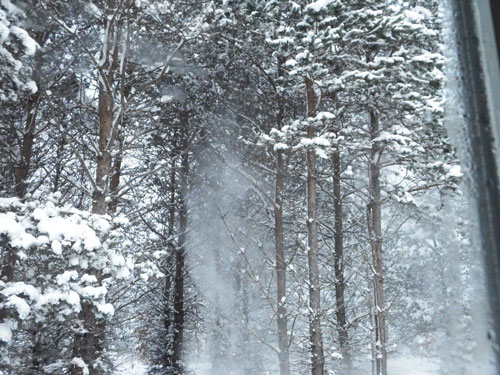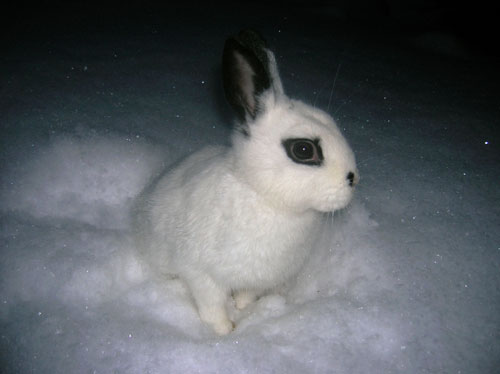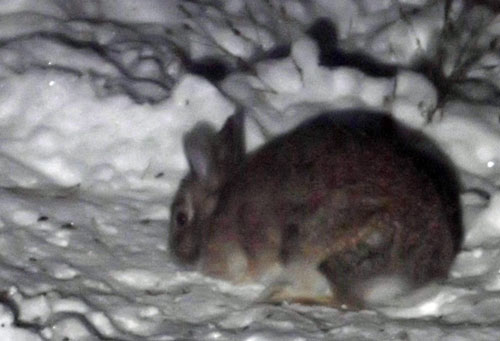Caring for Rabbits in the Winter
Last Updated on December 18, 2022 by Ellyn Eddy
Can rabbits live outside in the winter? Absolutely. But there are a few things you should know about cold-weather rabbit care if you’re going to keep your rabbits outside in sub-freezing temperatures.

This is the view out my window at the moment. I don’t think I’ll post a “selfie” right now, but if I did, you’d see I’m wearing a scarf. In the house. As usual.
It’s the day before Thanksgiving. I live in northern Michigan, and if we don’t have snow by this time of November, we wonder what’s going on. Some days I feel like I’d welcome global warming if that meant I didn’t have to thaw frozen water bottles in November. This year I was trudging through four inches of snow on my birthday, which was two weeks ago. We’ve got eight inches on the ground right now. And we’re sure grateful for our tank full of propane, because we’re burning through it fast.
I always feel for the little critters that live outside this time of year, both the wild animals and my domestic rabbits. It seems impossible to live in an environment where the temperature doesn’t touch above freezing for weeks at a time, and yet they make it through. Truth is that rabbits are built to handle winter weather much better than summer heat. My rabbits often look their best over the winter. They’re active and eager to see me rather than stretched out panting. Their coats are dense and not molting. Bitter cold is fatal for baby rabbits, but adult bunnies can do very well outside in the winter if you know how to care for them.
Care Tips for Pet and Show Rabbits Living Outside in Cold Weather

Water matters…as usual.
Water is the most important thing you can provide for your rabbits during the hot summer season. And guess what? It’s also the most important thing you can give them in the winter. If a rabbit doesn’t have water to drink, it won’t eat, and that can lead to G.I. Stasis quickly. Provide your rabbits with fresh water at least twice a day. It’s important any time of year, but especially when their water is going to freeze thirty minutes after they get it.
Since water freezes so quickly, it’s important to use the right watering equipment. I always use plastic crocks in the winter — no bottles, no glass, and no ceramic. (EZ crock, I’m your biggest fan.) Plastic will not crack when it expands, nor be as brittle if you drop it. I keep two water crocks for each rabbit, so I can alternate between them well letting the frozen crocks melt in the house for twelve hours. That’s a whole lot better than trying to work the ice cube out of each crock on the spot.
Rabbits will gnaw on the ice in their crocks, and sometimes this creates a hollow big enough that you’re tempted to just top it off with water instead of replace the whole crock. Don’t do it. Rabbits deserve a full dish of water which won’t freeze as fast as a little puddle on top of an ice cube. I’m talking to myself here…
Handling your bunnies matters…as usual.
I’m always talking about how important it is to take your rabbits out on a regular basis and look them over for signs of illness. This is especially true in the winter. Feeding rabbits in cold weather can be tricky: you never want to let them get too fat, and yet they burn many more calories when they’re trying to get warm. You need to watch your individual rabbits closely to make sure they are staying in good shape. Watch them in their cages to make sure they are eating and moving around normally. Take them out and feel their spines. Lack of water will bring out a rough spine quickly, even if the rabbit still looks chubby under its winter coat. In my experience, a rabbit who is suffering over winter will be very rough over the backbone.
Check your rabbits’ drop trays regularly. If it stops producing normal-looking droppings, you have a problem and need to act fast. (Take your rabbit where its warm, force-feed fluids, and keep it moving around, like you would a colicky horse.) Of course, you won’t be able to know if the droppings have stopped unless you clean your drop trays once or twice a week… so make a point to clean them, even though it’s literally a frozen nightmare to do on a dark, 16-degree evening when you get home from work.
What and how much should you feed rabbits over the winter?
How much should you feed your rabbits over the winter? Feed whatever will keep them in good condition. That’s always the rule. Where I live, the average high temp in January-February is under 30 and the average low hovers around 11 degrees Fahrenheit. It’s so cold that I want to make sure my rabbits have all the energy they need, so I full-feed. (Full feeding means filling up the cups so rabbits have constant access to food.) If you live in a warmer climate, you may find that your rabbits put on excess weight if you full-feed. Or you might not. My feeding program may not work for your rabbits, and yours may not work for mine. Develop a plan that’s best for your own bunnies.
A lot of breeders feed high energy supplements over the winter, such as calf manna or an oat/barley/sunflower seed mixture. I’ve never done this myself, but if you’ve got a bunny that’s underweight, those conditioners will help quickly.
Hay is always helpful for rabbits to have, including during winter.

Should you use electric heating devices? Nest box warming pads, heated dishes, heat lamps and so on?
I am very, very wary of using electric heating devices around rabbits. I strongly advise against them. Firstly because they are unnecessary. Barring very old and very young ones, rabbits can live outside in sub-freezing temperatures without issue. (If you’re still not convinced, check out the paragraph on wild rabbits in the winter, below.)
Secondly, I don’t think you should use electric heating devices due to the fire risk. Heated nest box pads very nearly killed our first two rabbits. We had the bunnies in a wooden hutch, tucked up to the house so the cords on the heating pads would reach the outlet. We were very careful to keep the cords out of reach of the bunnies’ teeth. And yet something caught fire. I thank God that we saw it from the window in time to rescue the rabbits, but they smelled like smoke for a long time.
In short, I don’t think the benefits of using electric heating devises with your adult rabbits are worth the risk. If you want to help keep your bunnies warm, give them a nest box stuffed with straw. Some bunnies will use it and some won’t, but at least it will make you feel like you did something.
What about a climate controlled rabbit barn?
If you plan to heat your whole bunny barn using electricity, that’s a different story. I do think that can be done safely: I’ve used an electric space heater in the barn without issues. There are better and worse ways to do it, but that’s a topic we’ll have to cover in another article. For now, let’s focus on keeping rabbits outdoors.
Breeding rabbits in the winter
Again, this is a topic we should save for another article. But I want to mention that it is totally possible to have success breeding rabbits in the winter: it’s just harder. Due to the lack of daylight, does will often be less receptive to the buck. However, if you use an artificial source to make sure she’s got 10-12 hours of daylight, you may be able to trick her body into thinking its spring. Once you’ve gotten a successful breeding, your biggest challenge will be keeping the babies alive in the cold. I usually bring the doe into the house or a heated area for a week before and after she kindles. After that I will leave the kits in the house and bring them out to the doe once or twice a day for feeding, until they are over two weeks old.

Above photo: a wild cottontail peeks out of his hole in our yard, wondering if he should come out yet.
How do the wild rabbits get through the winter?
My family loves to watch the wild animals that live in our yard. By day we feed the birds, and at night the wild cottontails come out to clean up the seeds that fell under the feeder. Unlike the ground squirrel and chipmunk that we see in the summer, wild rabbits do not hibernate over the winter. In fact, we see more wild rabbits when its snowy than at other times of the year. When they’ve finished the leftover sunflower seeds, they’ll nibble on the raspberry canes that grow outside their holes. During the day they stay in the shelter of their homes, cuddled up in their thick fuzzy coats. At dusk they come out and warm themselves with activity, showing off leaps and straight-up vertical springs that no domestic rabbit can match. I’m not sure how they make it through the winter, and yet somehow they do. So to celebrate the hardiness of the winter bunny, I’ll leave you with a few sweet pictures of our feeder friends. Happy winter!



Midnight flashlight photo-op



This squirrel is convinced he owns the feeder and everything near it. He’ll run off the jays without hesitation.
If you liked this article, please do me a favor and share it on your favorite networks. Thanks!